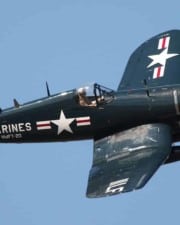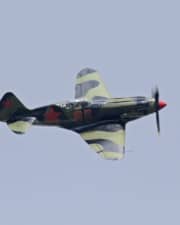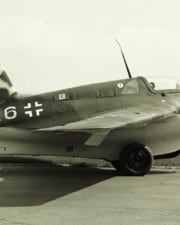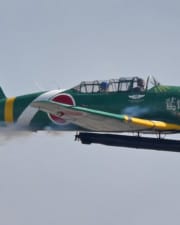When the Wright brothers took off for their first flight on 17 December 1903 in a motor-powered engine, they opened a whole new frontier of aviation and flying. It took almost half a century for successful jet aircraft to be operational, and German engineers led the way on this front. Are jet-engined aircraft one of the very few good things that have come out of World War 2?
With the aviation race on pre-WWII, engineers from around the world were given an overwhelming assignment of developing the best aircraft. While World War I mainly saw planes being used for reconnaissance, scouting, and gathering information, it was during the Golden Age of Aviation when innovation, creativity, and excellent engineering revolutionized aerial warfare and shifted war forever.
Across in Germany, Hans von Ohain was abuzz designing one of the most progressive inventions in the evolution of aviation – the world’s first operational jet engine. Using this design, he joined the Heinkel Company in Rostock, Germany, and the prototype for the Heinkel He 178, the first jet-powered aircraft, was born.
Despite the Treaty of Versailles forbidding Germany to have an air force, they continued making improvements designing, developing, testing, and manufacturing in secret. As a result of their well-advanced engineering and modernization, Germany’s Luftwaffe was the most powerful air force when the second world war began, boasting several innovative fighter and bomber plane designs.
World War II opened the skies for ingenuity and creativity which German engineers were well-skilled in.
Here’s a highlight of some of Germany’s most notable and impressive World War II jet-powered aircraft and designs.
1. Messerschmitt Me 262

Fast Facts:
- Engine: Two Juno 004B jet engines
- Max Speed: 540 miles per hour
- Range: 650 miles
Nicknamed the Schwalbe (Swallow) the Messerschmitt Me 262, with its jet engines and swept-wing design, soared into the annals of aviation history as the first jet engine to be flown in combat. On 25 July 1944, it first appeared when it attacked a British de Havilland Mosquito flying a reconnaissance mission over Munich.
Being at least 100 miles per hour faster than the era’s premier fighter, the North American P-51 Mustang, the Me-262 fundamentally shifted aerial combat. With its unmatched capabilities in bombing, this aircraft was a force to be reckoned with.
In the air, the Schwalbe pilots were able to use effective maneuvering and light controls to the maximum speed and perfectly harmonized flying. It was also able to hold its speed at tight turns, which was a great advantage in air dogfights.
However, it burnt jet fuel quickly, leaving a trail of exhaust smoke. This make it vulnerable to Allied forces who would merely follow the trail and then attack as the plane was landing. The jet fuel technology and speed required different piloting skills and pilots had to learn to fly again.
In 1945 the jet was captured by US Airforce. Some of its design features, including the swept wing, wing slots, and heavy cannon armament mounted on the nose were used by both American and British designers in later airplane prototypes.
There were 1400 Schwalbes built, but approximately only 300 saw active combat.
2. Heinkel He 162

Fast Facts:
- Engine: Single BMW 003 axial-flow
- Max Speed: 490 miles per hour
- Range: 606 miles
Although the war had already been waged for five years, the German Luftwaffe, put out an Emergency Fighter program competition for the design and production of a single seat-fighter, made of non-strategic materials, and that could be assembled using semi and non-skilled workers.
It took a mere three months to start large-scale production of this fighter jet after Heinkel was awarded the contract.
The Heinkel He 162 Salamander, engineered to be the Volksjager (People’s Fighter) was made mostly of wood and featured an uncomplicated tricycle landing gear, which was the first time such landing gears were commissioned.
Running short on manpower, it was envisaged that, with little training, novice pilots would be able to fly this fighter aircraft for air-to-air combat and to intercept inbound aerial threats. However, it was quickly established that this jet needed careful handling by experienced pilots.
The high winged monoplane with its downward hanging tips to improve lateral stability was the first operational jet fighter to feature an ejection seat.
Despite its innovative design features, the Salamander suffered from its flimsy material that caused the aircraft’s instability, and accidents caused by its inexperienced pilots. Only one combat victory was recorded on 4 May 1945 when it downed a British Hawker Typhoon.
With some improvements in design and functionality, the distinctive downward turning winglets on the wingtips conceptualized by Dr. Alexander Lippisch to correct longitudinal stability was the forerunner to drooped wingtips now widely utilized in gliders and light planes.
Records show that although 320 of these planes were produced, only 116 were delivered to the Luftwaffe before all the factories were captured by the Allied forces. The Heinkel He 162 would go into the history books as one of the worst fighter planes of WWII.
3. Arado Ar 234
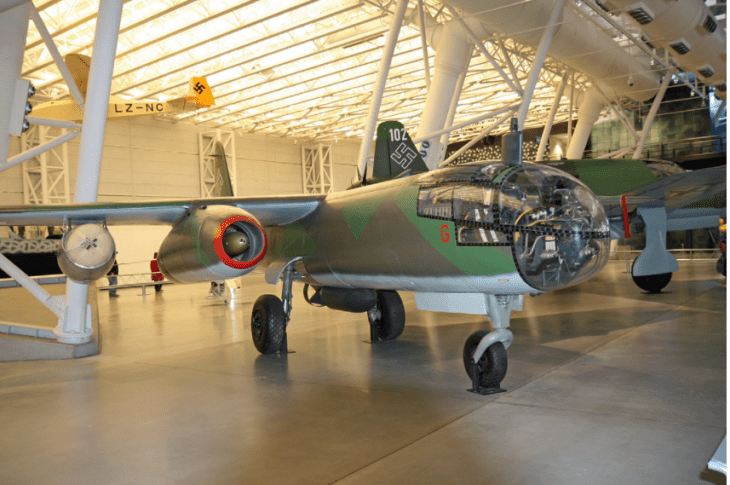
Fast Facts:
- Engine: A Junkers Jumo 004 engine under each wing
- Max Speed: 480 miles per hour
- Range: 1,240 miles
The Arado Ar 234, Blitz (Lightning) takes the honor as the world’s first operational jet-powered bomber used in combat. With the aircraft requirements detailed by the German Air Ministry, only one company responded to the challenge of designing and producing the bomber.
In 1941 the innovators at Arado, led by Walter Blume, Hans Rebeskhi, and Rudinger Kosin had their concept for the fast reconnaissance bomber accepted and approved, and production began.
When nine of them took to the skies on Christmas Eve 1944, they took Allied forces dug in around Liege, Belgium by surprise. In a historic bombing run, the turbojet engine planes, each carrying 1100 pound bombs, dropped their payload onto a factory complex and quickly soared away.
The Ar 234, with its rounded glass nose, operated well at all speeds. In another first in German innovation, a drag chute parachute mechanism was attached to the rear of the Ar 234 to help it land and provide stability.
Capturing the almost intact aircraft gave the Allied forces an opportunity to study its strengths and weakness. Some aerodynamic features were used in early American single-engine jet fighters such as the F-86 Sabre. The Soviet Union also captured Walter Blume, the designer of the Ar 234 and fighter pilot in WW1, to assist with the development of their own military aircraft.
Although records indicate that 214 Ar 234 were built, not many were actively deployed due to resource shortages experienced by Germany.
4. Focke-Wulf Ta 183

Fast Facts:
- Engine: One Heinkel HeS 011 turbojet
- Max Speed: 597 miles per hour
- Range: 615 miles
Although the war ended before the Ta 183 Huckebein (named in reference to a cartoon raven that makes trouble for others) could be put in operation as a front-line fighter, it first appeared on drawing boards as early as 1942, with six main design variants proposed.
Designed by a Kurt Tank team, led by engineer Hans Multhopp, the fifth design option presented ground-breaking technology for this high-altitude fighter. Its thin 40 degrees swept-back wings were designed to reduce turbulence by slowing down the air, thereby creating more lateral stability.
The center-positioned pressurized cockpit, with its bubble canopy, provided an excellent all-round vision for the pilot. The tricycle undercarriage landing gear gave the pilot a better view of the field and targets and by reducing exposure to crosswinds, also improved the aerodynamics.
While in exile in Argentina, Tank continued to work on the Ta 183 for the Argentinian government, and the IAe ‘Pulqui II” was crafted. It is also thought that the Soviet Union’s MiG-15 design was inspired by the Ta 183 documentation taken from Germany after the war.
5. Junkers Ju 287

Fast Facts:
- Engine: Four Junkers Jumo 004 B-1 engines
- Max Speed: 347 miles per hour
- Range: 963 miles
By 1943, when aeronautical engineer Hans Wocke proposed the experimental use of forward-swept wings for a jet-powered bomber, material, and components for manufacturing aircraft were scarce.
The building of the Junkers Ju 287, made by salvaging parts from damaged aircraft, is a somewhat unusual example of reducing and reusing material. The development initially began as a test-bed as its design was so unusual. Its nosedive was from an American heavy fighter, the main wheels from a Junkers’ transporter, the empennage from a Junkers heavy fighter, and the fuselage from a Heinkel heavy bomber.
The Ju 287’s ground-breaking forward-swept wings were the only part of the fast bomber that was not made of previously used material.
The fixed landing gear was another atypical feature of the Ju 287. This mechanism was lighter than retractable gear and eliminated the need to design storage apparatus to house the gear during flight.
Wocke, working with Ernst Zindel, recognizing the speed limitation of straight wings, proposed the use of the forward-angled wings. The bomber needed to operate at high speed but had to be stable during low-speed handling for accurate ground attack targeting.
After the war, Wocke, as head of the Hamburger Flugzeugbau’s engineering team, adapted the forward-swept wing configuration to develop the HFB 320, Germany’s first business jet or the Hansa Jet as it became known. This technology influenced aviation around the world, especially in the USA, Russia, and the United Kingdom who built their own prototypes.
An Italian construction materials company was the first business buyer of the passenger configurated jet. It was also used by the German Air Force for VIP transport duties and electronic countermeasure training to aircrews.
6. Horten Ho 229
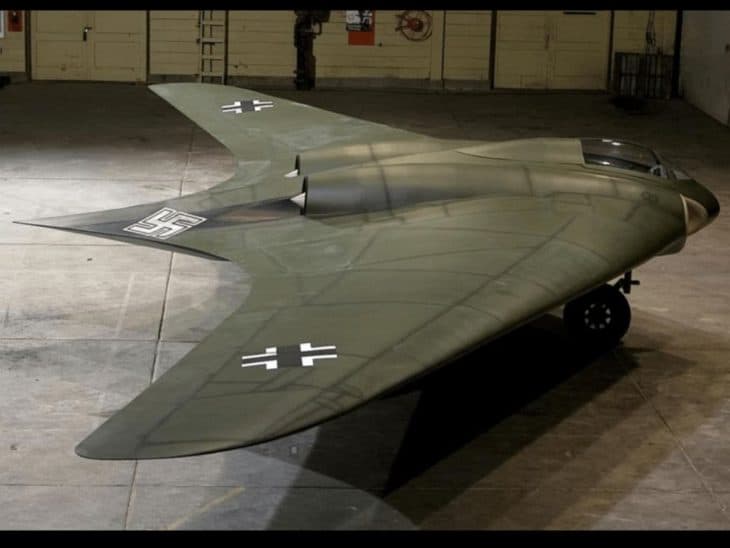
Fast Facts:
- Engine: Two Junkers Jomo 109-004C turbojet
- Max Speed: 607 miles per hour
- Range: 1,181 miles
Honors for the most unusual combat aircraft tested during WWII go to the all wing jet-propelled Horten Ho 229. What’s even more spectacular about this secret aircraft was that it was the world’s first stealth bomber.
Horten brothers Reimar, a talented designer, and Walter, an experienced fighter pilot, understood that the drag effect caused by vertical features on aircraft would reduce the speed of the aircraft. To address this, they studied the capabilities of flying wing designs using aerodynamic glider principles.
Its 50-foot wingspan bent back at a 32-degree angle and no tail make it possible for the Ho 229 to outpace the piston-driven American P-51 Mustang and the British Supermarine Spitfire.
The German Air Ministry stipulated that the aircraft be produced both as an aerial bomber of ground targets and as an air-to-air combat fighter. The Horten Ho 229 took off for its maiden flight on 1 March 1944.
The idea behind this flying wing was to meet the “3×1000” requirements. The goal was to design the aircraft to have the ability to carry 1000 kilograms of bombs, over 1000 kilometers, flying at a speed of 1000 kilometers per hour. Although those achievements were narrowly missed and only 3 were ever produced, the innovation and engineering were years ahead of their time.
As World War II was coming to an end, the U.S launched Operation Paperclip to collect German weapons research to prevent the technology from falling into the hands of the Soviet Union. A Ho 229 was transported to the US.
The flying wing technology is continually evolving in aeronautical designs in an attempt to improve aircraft efficiency. The Horten brothers would have been pleased that their flying wing designed aircraft inspired the fictional aircraft used in the film ‘Raiders of the Lost Ark.’
Related Posts



